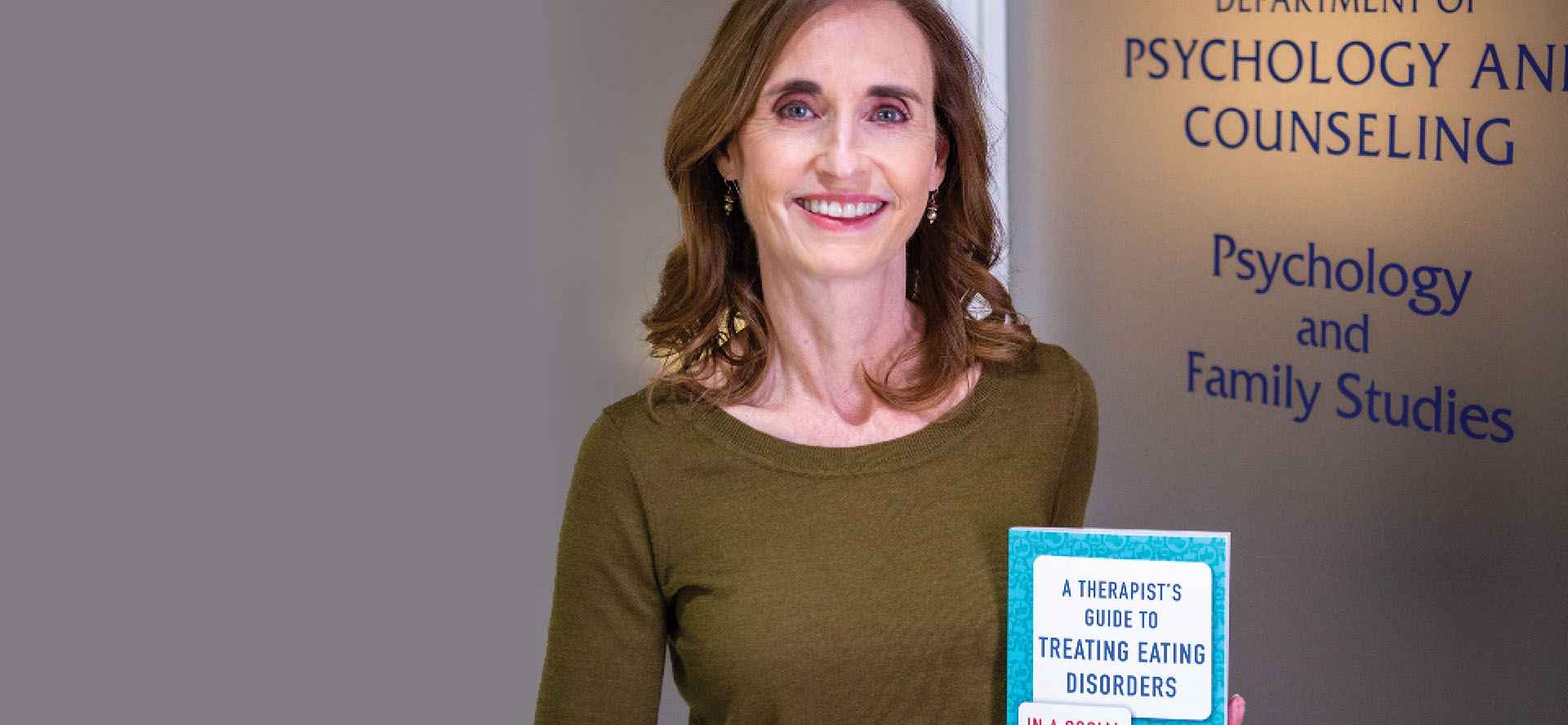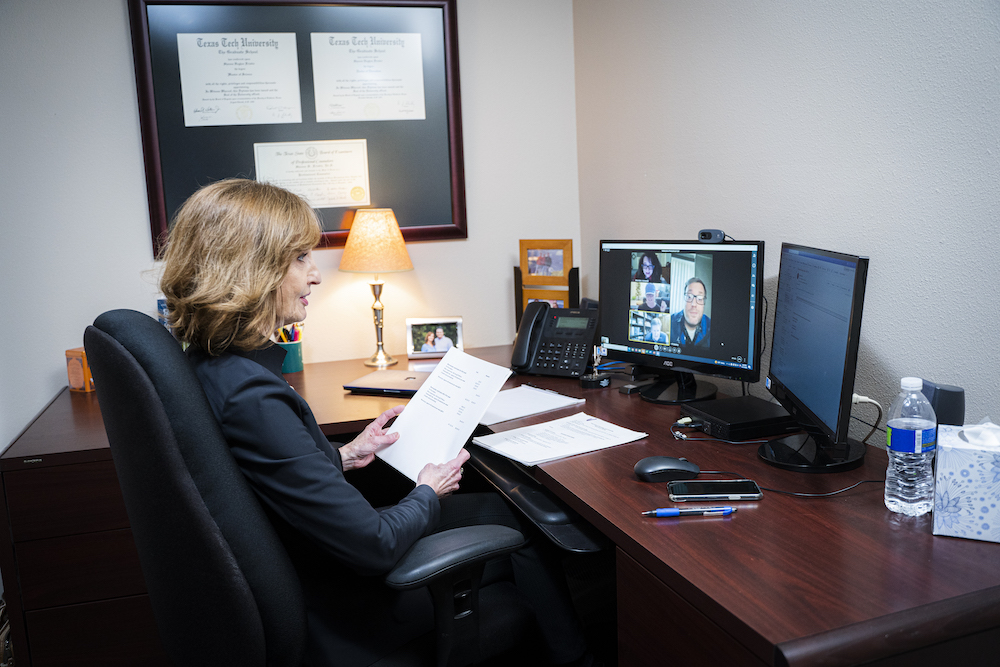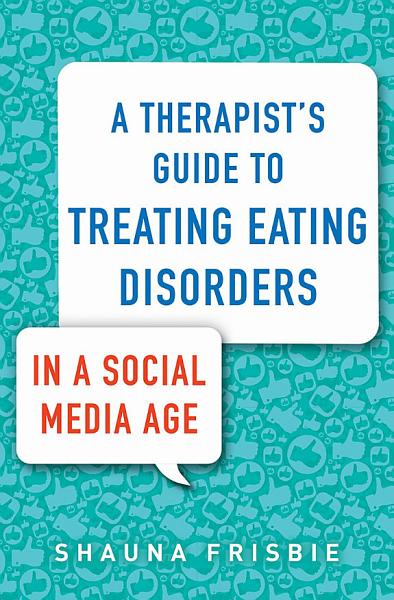
When Dr. Shauna Frisbie first went into mental health counseling, she didn’t do so with the intention of becoming an expert on eating disorders—but over twenty years later, she published A Therapist’s Guide to Treating Eating Disorders in a Social Media Age, a tool for counselors to help navigate how social media impacts disruptive behaviors caused by issues with body image.
Dr. Frisbie has been working in Lubbock Christian University’s Department of Behavioral Sciences since 2001, where she has taught undergraduate and graduate students in a variety of counseling and psychology courses.
When she first started teaching at LCU, she was finishing up her doctoral degree while also working in her own private practice, which she still maintains today. It was while working in a clinic during her doctoral program that she first discovered the need for specialists in eating disorders.
“I didn't really intend to do this, necessarily,” she explained, “but whenever we would get someone with an eating disorder issue, there was a reluctance for any of us to counsel them —none of us knew exactly what to do. There weren't a lot of resources in town, so I decided that I needed to get more expertise just to provide services.”
She began her research, and before long she found her private practice focusing on her new area of expertise. “I treat a lot of anxiety and depression, and other types of mood disorders, obsessive compulsive disorder, things like that—but I focus mostly on eating disorders and trauma.”
Dr. Frisbie explained that eating disorders are more common than most people realize.
“I think people have perceptions that eating disorders are about this emaciated teenage girl, but that's only a small percentage. When we look at eating disorders, less than 10% of diagnosed individuals are underweight—most look completely average, normal, slightly overweight, or even obese—body type covers the whole gamut.”
Not only do eating disorders cover all body types of people, but it also covers a wide variety of behaviors. “It really looks at people who restrict their diets, or who may binge and purge. Recently, we’ve added a diagnosis called binge eating disorder, which we often see in males. About 9% of the population worldwide has an eating disorder during their lifetime.”
One of the most common ways to identify an eating disorder, she says, is by looking at how excessive the behavior is. “That sounds very vague, but people can usually identify this excessive behavior, whether that might be purging, over-exercising, taking laxatives or even diuretics, which are all kinds of what we call compensatory behaviors.”
Another disorder that she treats is called Avoidant/Restrictive Food Intake Disorder. “It's a little different than anorexia because clients may not feel like they're overweight, as people with anorexia typically do. They will often have a sensory problem—in other words, they’ll tell me, ‘I just can't eat certain textures,’ or, ‘I can’t eat certain colored foods.’ Eating disorders cover a broad spectrum of eating behaviors.”
Dr. Frisbie’s most recent research includes the effects that social media have on individuals with these types of disorders.
One of the angles from which Dr. Frisbie approached her research was to investigate how images affect us. “I've been involved in photography and visual arts for a long time,” she explained. “If you think about it, social media today is all images. In the early days, it was a lot of text posting and things like that, and not as many visual components. But now, almost every post contains an image or video. I just began to do research.”

Dr. Frisbie has taught graduate and undergraduate courses at LCU for over two decades.At first, she said, it was hard to find anything substantive on social media and its effects. “There wasn’t much out there at first—and now what's happened is that we first got a lot of good research on Facebook, and then Instagram, but we don't have much research on TikTok. Unfortunately, it takes a while for research to catch up with what's going on out in the world,” she explained, “because it must go through this vetting process. You first have to collect the data, then you have to get it published, and all of that takes time—and social media moves fast.”
One of the most helpful answers to that struggle, she found, was to focus on which concepts are common to social media. “A lot of it is applicable, I think, because when we read things about Instagram, we can go, ‘Oh, okay, I can see how TikTok would be similar as well.’ Some of those concepts still apply across different platforms.”
Even so, the rise of different platforms has been interesting to track. “Today, TikTok and YouTube are probably the most widely used platforms,” she explained. “If you looked a few years ago, it would have been Instagram.”
“As faculty, we learn a great deal from our students. Some of those students were the ones who introduced me to TikTok—but not because they were using it. They were graduate students who were counseling middle schoolers, and they would come to class talking about these videos that these middle schoolers were watching and making.”
One of the most important emphases within her study of social media and mental health has been examining the addictive nature of these platforms.
“Last spring, I taught an undergraduate class called social media and psychology,” she continued. “The students were very insightful as they examined the behavior, and we were getting underneath and saying, ‘Okay, what are the psychological principles under the attraction, and what it's doing to us? How is it hooking us?’ That’s what I really wanted them to understand. Ultimately, what I want it to do is impact their behavior, right? Not because they're doing horrible things, but because it's important that we all understand how social media is capturing us and what it's doing to us. And then if these students are going to one day be parents, or if they’re going to teach in the future, then they’re going to interact with young people and they’re going to need tools to guide them because social media is not going to go away.”
Dr. Frisbie found that the image-centric nature of social media is specifically important in examining its impact on clients with eating disorders.
“Because of my interest in photography, I went back and started looking at the research on photographs, and why we get fooled by photographs. When we look at a photograph, we assume it's reality. If I ask someone to show me a photo of their mom, they’ll usually reply, ‘This is her.’”
“Our visual system is closely tied into our emotional system in our brain physically,” she continued, “so when we see these things, we're also triggered more by visual images than we are by reading something. Think about reading a horror novel—it might be scary, but then if you see the movie, you might not be able to tolerate it. Images bring up a lot of unconscious things that we don't even recognize—they make us think things are real that aren't. We call this a reality gap. And then you add in editing programs—Photoshop, Snap Chat filters—so what we're actually seeing isn’t even real, but our brain doesn't know that.”
“There are a few studies that are coming out that tell us people who are on Instagram more are more likely to compare themselves with others physically,” she explained. “When you compare yourself with other people, your anxiety goes up, and your self-esteem goes down. It's what happens to us when we've used social media. Our brains aren’t equipped to deal with what we've invented.”/p>
It was from that research that she began working on her book, A Therapist’s Guide to Treating Eating Disorders in a Social Media Age.
“When I wrote the book on social media and eating disorders, I was trying to give other counselors skills to work with images that their clients are bringing in. Eating disorders were just the natural context because I was already treating it, and we had so much of that with these disorders. When you’re treating young people who are often obsessed with their bodies, they're taking a lot of photos of themselves, and they’re often obsessed with changes that we probably might not even be able to see. There's a lot of focus on appearance, and it's not all like weight loss—some of it is just appearance. There was a need for a resource, because there just wasn’t much else out there.”
Her book was published in 2020 by Norton Professional Books, who list it as, “An innovative therapeutic approach for counteracting the impact of social media on eating disorders and identity formation.” The listing goes on to explain, “Shauna Frisbie utilizes phototherapy techniques to view client-selected images (whether they be of themselves or others) to help uncover underlying messages that are impacting their relationship to their bodies. Integrating concepts of healing narratives, neuroscience, and phototherapy, this book will help any therapist promote self-compassion, self-reflection, and healing in their clients.”
“It was published at an interesting time,” Dr. Frisbie explained, “because it was already written and ready to go, and then the pandemic hit. People were confined to their houses, and particularly for people with eating disorders, symptoms went way up during the pandemic. People were really struggling—they were locked down in their homes, there was of a lack of access to groceries, and we also didn’t have things to go do. For many people this triggered disordered eating, and this is continuing. We have seen large increases in mental health issues with young people as we continue looking at mental health trends, and when you start looking at this, statistically, we see the biggest jumps when social media was conceived, and when the iPhone came out. That research has really helped us understand that what we're doing on our phones— primarily social media, and a lot of that is visual—is impacting our brain in some detrimental ways.”
Dr. Frisbie explained that the reactions that occur in a person’s brain when they’ve become addicted to social media are like those produced by many other addictive behaviors.
“If someone sees something that’s stimulating to them on their phone, they get a dopamine hit,” she said. “We all do—just like when someone does something well in a video game, there’s stimulating feedback, and their brain gets a dopamine hit. That's our pleasure and pain responses, which are in the same part of our brain, and so we get this pleasure from it. But then our brain tries to regulate those levels, taking dopamine receptors offline to balance it out. And when that happens, we’ll usually hit a low. It’s just like when people go on a vacation that they’ve been looking forward to and are so excited about, but then when they come back home, and there’s that bit of depression that hits. We get those kinds of feedback all the time, and it’s the same with our phones—that’s why we go back for another hit, and that's what brings us back again and again, that's what makes us panic if we don't have our phone.”
Dr. Frisbie says that, when paired with that addictive nature, the constant stream of images on social media can distinctly alter views of self-image.

Dr. Frisbie hopes that her book, "A Therapist's Guide to Treating Social Media Disorders in a Social Media Age," will be a tool for therapists and students alike.“Think about how much our sense of who we are is developed by feedback from other people. That used to come from a small circle, even back when I was in school with my group of friends. Today, however, social media has expanded that exponentially, and that’s altered what the norms are for appearance. What people think of as standards of beauty are not realistic. While we might know that cognitively, that doesn't always translate to emotions and our subconscious.”
She explained that studies have shown clearly that social media exposure changes the users’ sense of body image and their experience of self-acceptance. Even if somebody doesn't have an eating disorder, high social media usage still changes the way they view themselves and others—and she emphasized it's not just among women.
“Eating disorders are a huge topic,” she said. “When I first started treating them—I thought, ‘This can't be too hard, there are only like three or four diagnoses in here.’ But it is the hardest work I do. These disorders can be very long and chronic, because they’re dealing with our identity—they’re ingrained, and treatment often hinges on changing day-to-day behaviors, which is inherently difficult.”
“I think, as a culture, we have very toxic relationships with talking about weight and bodies,” she explained. “I get clients all the time that tell me about their families and how critical their families are of weight. That is the focus of conversation at almost every family gathering for some of these clients—who's gained or lost weight, who ‘looks good’ and who ‘looks bad.’ A lot of families seem to be obsessed with it, and then that has an impact on kids as they grow up.”
“My book explores not only how social media affects eating disorders, but also how we can work and use images that people are seeing and posting on social media therapeutically.”
She explained that, over the years of treating eating disorders, she noticed that clients would often bring up social media, and even pulling out their phones to show photos in sessions.
“That wasn't nearly as common in, say, 2011,” she explained. “People weren't carrying around phones that had WiFi capabilities, so we didn't see that. But today we’re seeing people coming into the office saying, ‘I want to show you this,’ and they're showing either photos that they're seeing online, or posted photos they've taken of themselves, and it's just such a different environment. I became really fascinated with trying to figure out how this is impacting my clients—what do we do with it?”
“That's what really prompted the book in the first place,” she continued. “It explores not only the relationship between how social media affects eating disorders, but also how we can work and use images that people are seeing and posting on social media therapeutically.”
Despite the problems posed by social media, Dr. Frisbie explained that it also can be used as a tool in therapy.
“I started working with my clients because they were bringing in social media and photos, and I had to figure out what to do with it. I started thinking about work I’d been engaged with called Photo Therapy, where people would bring photos into my office of them as children or their family, and they would use them to tell their story. There’s something deeply therapeutic about that, and so I began exploring, why am I not doing that with the content these people are bringing in off social media? That's where I begin doing this specific work.”
Dr. Frisbie has continued her research even after her work was published. “I've written the book, but I know I need to keep adding to this research. Our psychology students are going to need strong research on these topics—not just eating disorders, but social media, because these platforms will continue to impact people. At the core, it's about trying to fix something in our life.”